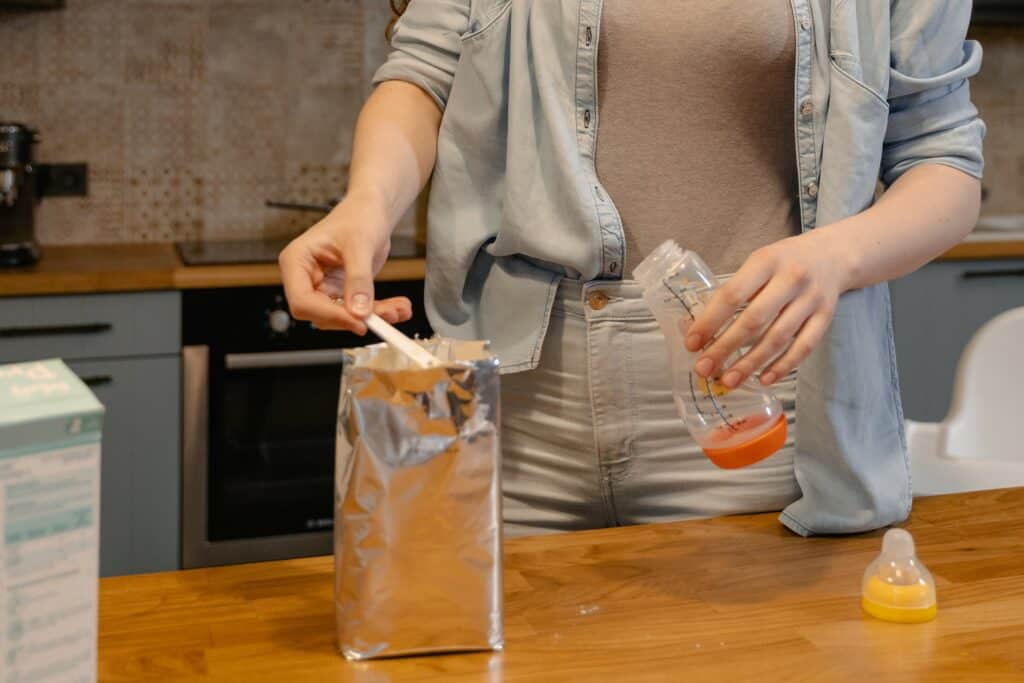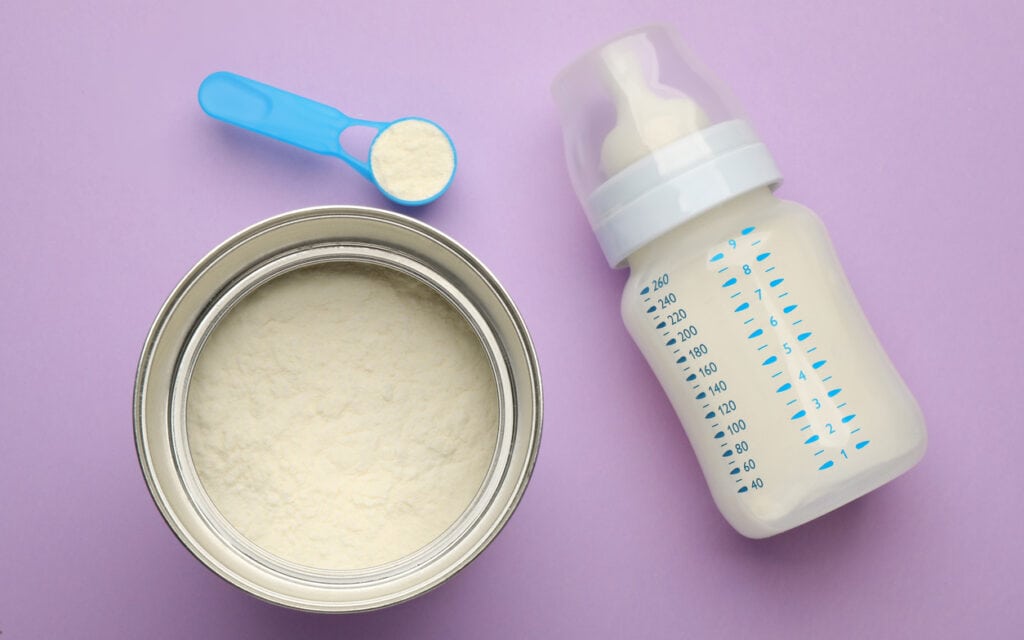When it comes to feeding your baby, formula is often a go-to option for parents who are unable to breastfeed or choose not to. However, not all babies take to formula easily, and some may even refuse it altogether. This can be a frustrating and worrying experience for parents who want to ensure their baby is getting the nutrition they need.
Understanding why your Baby Doesn’t Like Formula is the first step in addressing the issue. There are a variety of physical factors that can influence a baby’s dislike for formula, such as an allergy or sensitivity to certain ingredients. Additionally, transitioning from breastfeeding to formula can be a difficult adjustment for some babies, who may prefer the taste and texture of breast milk.
Key Takeaways
- There are many reasons why a baby may not like formula, including physical factors and a preference for breast milk.
- Choosing the right formula and bottle and nipple selection can make a difference in your baby’s acceptance of formula.
- Involving your pediatrician and monitoring your baby’s health are important steps in addressing feeding issues.
Understanding Why Your Baby May Not Like Formula
Babies may refuse formula for a variety of reasons, including taste or texture, dietary, and behavioral factors. Understanding why your baby may not like formula can help you address the issue and find a solution.

1. Taste or Texture
Some babies may dislike the taste or texture of formula. Formula may taste different from breast milk and some babies may prefer the taste of breast milk. Additionally, some babies may find the texture of formula to be too thick or too thin.
2. Dietary Factors
Babies may refuse formula if they are not hungry or if they are getting enough nutrients from other sources. For example, if a baby is eating solid foods, they may not need as much formula.
3. Behavioral Factors
Babies may refuse formula if they are experiencing behavioral issues such as fussiness or crying. Some babies may associate formula with discomfort or an upset stomach, which may cause them to refuse it.
If your baby is refusing formula, it is important to talk to your pediatrician to rule out any underlying medical issues. Additionally, trying different types of formula or adjusting feeding schedules may help address the issue.
Physical Factors Influencing Baby’s Dislike for Formula
There are several physical factors that can influence a baby’s dislike for formula. These factors can range from minor discomfort to serious health issues. Here are some of the physical factors that may be contributing to your baby’s dislike for formula:

1. Gas and Gassy Sensations
Babies can experience gas and gassy sensations when they consume formula. This can be due to the composition of the formula, the way the baby is fed, or other factors. Gas can cause discomfort and pain, which may make the baby refuse to drink the formula.
2. Pain and Illness
If a baby is in pain or is feeling unwell, they may refuse to drink formula. This can be due to a variety of reasons, such as teething, fever, or illness. It is important to monitor your baby’s health and seek medical attention if necessary.
3. Teething
Teething can cause discomfort and pain, which may make it difficult for a baby to drink formula. Teething can also cause excessive drooling, which can make it difficult for the baby to swallow.
4. Colic
Colic is a condition that causes excessive crying and fussiness in babies. It can be caused by a variety of factors, including gas, reflux, and other digestive issues. Colic can make it difficult for a baby to drink formula, as they may be too upset to eat.
5. Reflux
Reflux is a condition where stomach acid flows back into the esophagus, causing discomfort and pain. Reflux can make it difficult for a baby to drink formula, as they may experience pain and discomfort when swallowing.
6. Constipation
Constipation can cause discomfort and pain, which may make it difficult for a baby to drink formula. It is important to monitor your baby’s bowel movements and seek medical attention if necessary.
7. Difficulty Breathing
If a baby is having difficulty breathing, they may refuse to drink formula. This can be due to a variety of reasons, such as a stuffy nose or respiratory illness.
Overall, it is important to monitor your baby’s health and seek medical attention if necessary. By addressing physical factors that may be contributing to your baby’s dislike for formula, you can help ensure that your baby is healthy and happy.
Transitioning from Breastfeeding to Formula
Transitioning from breastfeeding to formula can be a challenging process for both the mother and the baby. It is essential to understand that every baby is different, and some may take longer to adjust to the new feeding routine. Here are some tips to help make the transition as smooth as possible:

1. Introduce Formula Gradually
It is essential to introduce formula gradually to allow your baby’s digestive system to adjust to the new feeding routine. Start by replacing one feeding session with formula and gradually increase the frequency over time. You can also mix breast milk and formula to help your baby adjust to the new taste gradually.
2. Offer the Bottle at the Right Time
It is crucial to offer the bottle when your baby is hungry but not starving. If your baby is too hungry, they may become frustrated with the bottle and refuse to take it. On the other hand, if your baby is too full, they may not be interested in the bottle.
3. Use the Right Bottle and Nipple
Choosing the right bottle and nipple can make a significant difference in your baby’s feeding experience. Look for bottles that mimic the shape and feel of the breast, and nipples that are appropriate for your baby’s age and feeding needs.
4. Be Patient
Transitioning from breastfeeding to formula can take time, so it is essential to be patient and persistent. Don’t give up if your baby refuses the bottle at first. Keep offering the bottle and try different techniques until you find what works best for your baby.
In conclusion, transitioning from breastfeeding to formula can be a challenging process, but with patience and persistence, it can be successful. Remember to introduce formula gradually, offer the bottle at the right time, use the right bottle and nipple, and be patient.
Choosing the Right Formula
When it comes to choosing the right formula for your baby, it can be overwhelming with so many options available in the market. However, it is essential to understand that not all formulas are created equal, and what might work for one baby may not work for another. Here are some factors to consider when choosing the right formula for your baby.

1. Protein
Protein is a crucial component of baby formula, and it is essential to choose a formula that has the right amount of protein. Most formula brands, such as Enfamil and Similac, offer a range of options with varying protein levels. It is essential to consult with your pediatrician to determine the appropriate protein level for your baby’s needs.
2. Allergies
If your baby has allergies or a family history of allergies, it is crucial to choose a formula that is hypoallergenic. Hypoallergenic formulas are designed to be gentle on the baby’s digestive system and reduce the likelihood of allergic reactions.
3. Make Baby Formula Taste Better
Some babies may not like the taste of formula, and parents may want to make it taste better. However, it is essential to avoid adding sweeteners or other additives to the formula. Instead, try warming the formula or adjusting the temperature to room temperature. Additionally, some formula brands offer different flavors, such as vanilla, that may appeal to some babies.
4. Switching Formula
If your baby is not responding well to a particular formula, it may be necessary to switch to a different brand or type. However, it is essential to consult with your pediatrician before making any changes to your baby’s diet. Abruptly switching formulas can cause digestive issues and other problems.
In conclusion, choosing the right formula for your baby is a crucial decision that should be made in consultation with your pediatrician. Factors such as protein levels, allergies, and taste preferences should be considered when selecting a formula. If your baby is not responding well to a particular formula, consult with your pediatrician before making any changes.
Bottle and Nipple Selection
Selecting the right bottle and nipple for your baby can be a daunting task. There are so many options available in the market that it can be overwhelming for new parents. However, choosing the right bottle and nipple is crucial for your baby’s feeding experience.

When selecting a bottle, consider the following factors:
- Material: Bottles are available in glass, plastic, and silicone. Glass bottles are durable but heavy, while plastic bottles are lightweight but may contain harmful chemicals. Silicone bottles are a good alternative to plastic as they are lightweight and safe.
- Size: Bottles come in different sizes ranging from 2 oz to 10 oz. Choose a size that is appropriate for your baby’s age and feeding needs.
- Shape: Bottles come in different shapes such as wide-neck, narrow-neck, and angled. Wide-neck bottles are easier to clean, while angled bottles are helpful for babies with reflux.
When selecting a nipple, consider the following factors:
- Material: Nipples are available in latex and silicone. Latex nipples are soft and more flexible, while silicone nipples are firmer and more durable.
- Size: Nipples come in different sizes ranging from slow flow to fast flow. Choose a size that is appropriate for your baby’s age and feeding needs.
- Shape: Nipples come in different shapes such as round, orthodontic, and flat. Choose a shape that is comfortable for your baby.
It is important to note that some babies may prefer certain bottle and nipple combinations over others. If your baby is having trouble with a particular bottle or nipple, try a different one until you find the right fit.
Feeding Techniques and Positions
Feeding a baby who doesn’t like formula can be a challenging task, but there are several techniques and positions that can help make the feeding process easier and more comfortable for both the baby and the caregiver.

Feeding Positions
The feeding position can make a big difference in how well a baby takes to the formula. Here are a few positions to try:
- Cradle hold: This is a classic feeding position where the baby lies on their back with their head in the crook of the caregiver’s arm. The baby’s body should be facing the caregiver’s body, and the caregiver can use their other hand to hold the bottle and guide it into the baby’s mouth.
- Football hold: In this position, the baby is held under the caregiver’s arm with their head near the caregiver’s elbow. This position can be helpful for babies who have trouble latching onto the bottle or who have reflux.
- Side-lying position: This position is ideal for nighttime feedings, as it allows both the baby and the caregiver to lie down. The baby lies on their side facing the caregiver, and the caregiver can offer the bottle while lying down next to the baby.
Distracted During Feedings
Many babies can become easily distracted during feedings, which can make it difficult for them to finish their formula. Here are a few tips to help minimize distractions:
- Create a quiet environment: Turn off the TV and minimize other noise in the room to help the baby focus on the feeding.
- Avoid eye contact: Some babies become distracted when they make eye contact with their caregiver. Try feeding the baby while looking away or with your eyes closed.
- Use a nursing cover: For babies who are easily distracted by their surroundings, a nursing cover can help create a more private and calming environment.
Routine
Establishing a feeding routine can help babies feel more comfortable and secure during feedings. Here are a few tips for creating a feeding routine:
- Feed on a schedule: Try to feed the baby at the same time each day to establish a routine.
- Follow a consistent feeding pattern: For example, always burp the baby after every ounce of formula.
- Offer comfort: After the feeding is complete, offer the baby comfort and cuddles to help them feel secure and relaxed.
By trying different feeding techniques and positions, minimizing distractions, and establishing a feeding routine, caregivers can help make the feeding process easier and more enjoyable for both themselves and their baby.
Involving Your Pediatrician
If your baby is not liking formula, it is important to involve your pediatrician in the process. They are trained professionals who can offer valuable advice and guidance. Here are some ways to involve your pediatrician:

- Schedule an appointment: Make an appointment with your pediatrician to discuss your baby’s feeding issues. They can evaluate your baby’s health and determine if there are any underlying medical conditions that may be causing the feeding problem.
- Discuss feeding options: Your pediatrician can provide you with various feeding options that may work better for your baby. They can also recommend different formulas that may be easier for your baby to digest.
- Follow their advice: It is important to follow the advice of your pediatrician. They may recommend changes to your baby’s feeding schedule or suggest different formulas. It is important to follow their advice to ensure that your baby is getting the nutrition they need.
- Join support groups: Your pediatrician may be able to recommend support groups for parents who are experiencing feeding issues with their babies. These groups can provide valuable emotional support and advice.
According to the American Academy of Pediatrics, it is important to involve your pediatrician when your baby is not liking formula. They can provide valuable advice and guidance to help you find a solution. The Mayo Clinic also recommends involving your pediatrician to ensure that your baby is getting the nutrition they need.
When to Introduce Solid Foods
Introducing solid foods to a baby is an exciting milestone for parents, but it’s important to wait until the baby is developmentally ready. The American Academy of Pediatrics recommends waiting until the baby is at least 6 months old before introducing solid foods.

Before this age, a baby’s digestive system is not fully developed, and introducing solid foods too early can increase the risk of allergies and other health problems. It’s also important to note that breast milk or formula should still be the main source of nutrition for the baby until 12 months of age.
When the baby is ready for solid foods, it’s important to introduce them slowly and one at a time. This will help identify any allergies or intolerances the baby may have. It’s also important to offer a variety of foods to help the baby develop a taste for different flavors and textures.
Some parents choose to practice baby-led weaning, which involves allowing the baby to self-feed with finger foods instead of spoon-feeding purees. This approach can help promote independence and healthy eating habits, but it’s important to make sure the baby is developmentally ready and to always supervise mealtime.
It’s common for babies to be picky eaters, but it’s important to continue offering a variety of healthy foods and not force the baby to eat anything they don’t want to. It may take several tries before a baby accepts a new food, so patience is key.
In summary, introducing solid foods should be done when the baby is developmentally ready and at least 6 months old. Introduce foods slowly and one at a time to identify any allergies or intolerances. Consider baby-led weaning if it aligns with your parenting style, but always supervise mealtime. Finally, be patient with picky eaters and continue offering a variety of healthy foods.
Safety Measures and Precautions
When it comes to preparing and storing formula, there are several safety measures and precautions that should be taken to ensure the health and wellbeing of the baby.
Firstly, it is important to always check the temperature of the formula before feeding the baby. The formula should be warm, but not hot, as hot formula can burn the baby’s mouth and throat. A good way to check the temperature is to test it on the inside of your wrist, as this area is sensitive to heat.
Microwaving formula is not recommended, as it can create hot spots in the liquid that can burn the baby’s mouth and throat. If you need to warm up the formula quickly, it is best to place the bottle in a bowl of warm water for a few minutes.
When storing formula, it is important to follow the manufacturer’s instructions for how long it can be stored and at what temperature. Formula that has been left out at room temperature for too long can spoil and become unsafe to consume. It is also important to label the bottle with the date and time it was prepared, so you can keep track of how long it has been stored.
In addition, it is important to always wash your hands and any equipment used to prepare the formula thoroughly before and after use. This helps to prevent the spread of harmful bacteria that can make the baby sick.
By following these safety measures and precautions, parents can help ensure that their baby is receiving safe and healthy formula.
Monitoring Your Baby’s Health
When a baby refuses to take formula, it can be concerning for parents. It is important to monitor the baby’s health to ensure they are getting the proper nutrition they need.

One key indicator of a baby’s health is their weight gain. If a baby is not gaining weight as expected, it could be a sign of malnutrition. Parents should regularly monitor their baby’s weight to ensure they are growing at a healthy rate.
Another indicator of a baby’s health is their hunger cues. If a baby is consistently showing signs of hunger, such as fussiness or rooting, it could be a sign that they are not getting enough to eat. Parents should offer the baby formula frequently and monitor their feeding patterns.
In addition to monitoring weight gain and hunger cues, parents should also pay attention to any other signs of illness or discomfort in their baby. If a baby is showing signs of illness or is not behaving normally, parents should consult with their pediatrician.
Overall, monitoring a baby’s health is crucial when they are not taking formula. By paying attention to weight gain, hunger cues, and other signs of illness, parents can ensure their baby is getting the proper nutrition they need to thrive.
Related Post: Clear Liquid Spitting Up in Formula-Fed Babies: Causes and Solutions
Frequently Asked Questions
Why is my baby refusing formula?
There could be several reasons why a baby is refusing formula. It could be due to an allergy or intolerance to the formula, a dislike of the taste or texture, or a preference for breast milk. It is important to consult with a pediatrician to rule out any underlying medical issues.
What are some reasons to switch baby formula?
Some reasons to switch baby formula include an allergy or intolerance to the current formula, digestive issues such as colic or reflux, or a preference for a different brand or type of formula. It is important to consult with a pediatrician before making any changes to a baby’s diet.
How can I get my baby to drink formula?
There are several strategies that can be used to encourage a baby to drink formula. These include offering the formula at different temperatures, using a different type of bottle or nipple, and adding a small amount of breast milk to the formula to improve the taste. It is important to be patient and persistent, and to consult with a pediatrician if the baby continues to refuse formula.
What are the side effects of changing baby formula?
Changing baby formula can cause temporary digestive issues such as constipation, diarrhea, or gas. It is important to monitor the baby’s symptoms and consult with a pediatrician if the symptoms persist or worsen.
How long does it take for a baby to adjust to new formula?
It can take up to two weeks for a baby to fully adjust to a new formula. During this time, the baby may experience temporary digestive issues such as constipation, diarrhea, or gas. It is important to monitor the baby’s symptoms and consult with a pediatrician if the symptoms persist or worsen.
When should I switch formula due to gas?
If a baby is experiencing excessive gas or colic, it may be necessary to switch to a different type of formula. A pediatrician can recommend a formula that is specifically designed to reduce gas and improve digestion. It is important to consult with a pediatrician before making any changes to a baby’s diet.

Iesha is a loving mother of 2 beautiful children. She’s an active parent who enjoys indoor and outdoor adventures with her family. Her mission is to share practical and realistic parenting advice to help the parenting community becoming stronger.
